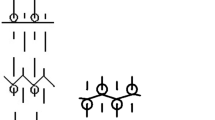Abstract
The aim of this research is to investigate shield effect properties of the fabrics with inox yarns included in the construction, which are used for special professional garments and should protect from electromagnetic microwave irradiation. The investigation was done prior to and after the professional care procedures of dry and wet cleaning in ten cleaning cycles. Shield effect measurements were done on the face and on the back of the fabric, weftwise and warpwise, prior to and after the first, third, fifth, seventh and tenth cycles of dry and wet cleaning, at the frequencies from 0.9 to 2.4 GHz. The results obtained indicated that shield effect of the fabric tested was reduced after professional care procedures, especially so after 5 cycles. The investigations also revealed that shield effect could be considerably enhanced if the inox yarns were incorporated into the fabric in the direction of the warp.
Similar content being viewed by others
References
S. Brzezinski, T. Rybicki, I. Karbownik, G. Malinowska, E. Rybicki, L. Szugaje, M. Lao, and K. Sledzinska, Fibres Text. East. Eur., 2, 66 (2009).
J. Koprowska, M. Pietranik, and W. Stawski, Fibres Text. East. Eur., 3, 39 (2004).
D. Duran and H. Kadoglu, Tekst. Konfeksiyon, 4, 354 (2012).
S. Maity, K. Singha, P. Debnath, and M. Singha, J. Saf. Eng., 2, 11 (2013).
M. S. Ozen, I. Usta, A. Beyit, M. Uzun, E. Sancak, and E. Isgoren, “RMUTP International Conference Textiles & Fashion 2012”, pp.1–14, Pullman Bangkok King Power, Bangkok, 2012.
S. Varnaite and J. Katunskis, Fibres Text. East. Eur., 17, 69 (2009).
K. Malarić, “EMI Protection for Communication Systems”, pp.141–145, Artech House, Boston, 2010.
K. Malarić, “Protection of Radiocommunication Systems”, p.9, Faculty of Electrical Engineering and Computing, Zagreb, 2005.
H. I. Nurul, A. Rusnani, A. Azuwa, A. S. Meor, and M. T. T. Faizal, “2011 IEEE International Conference on Control System”, pp.551–556, Universiti Teknikal Malaysia Melaka, Melaka, 2011.
K. R. Foster, Health Physic., 92, 3 (2007).
Y. G. Gfugoevervu, “IEEE 6th International Symposium on Electromagnetic Compatibility and Electromagnetic Ecology”, pp.9–14, St. Petersburg, 2005.
M. Rau, A. Iftemie, O. Baltag, and D. Costandache, Adv. Electr. Comput. Eng., 11, 17 (2011).
A. Das, V. K. Kothari, A. Kumar, and S. Tuli, Indian J. Fibre. Text. Res., 34, 144 (2009).
B. Šaravanja, K. Malarić, T. Pušić, and D. Ujević, Fibres Text. East. Eur., 1, 104 (2015).
K. E. Grabowska, K. Marciniak, and I. L. Ciesielska-Wróbel, Text. Res. J., 81, 1578 (2011).
K. B. Cheng, M. L. Lee, and T. H. Ueng, Text. Res. J., 71, 42 (2001).
I. Ciesielska-Wrobel and K. Grabowska, Fibres Text. East. Eur., 91, 53 (2012).
J.-S. Roh, Y.-S. Chi, T. J. Kang, and S.-W. Nam, Text. Res. J., 78, 825 (2008).
H. Ozdemir and A. Ozkurt, Tekstil, 62, 134 (2013).
F. Ceken, G. Pamuk, O. Kayacan, A. Ozkurt, and S. S. Ugurlu, J. Eng. Fiber. Fabr., 4, 81 (2012).
F. Ceken, O. Kayacan, A. Ozkurt, and S. S. Ugurlu, Tekstil, 60, 295 (2011).
IEEE STD 299 Standard Method for Measuring the Effectiveness of Electromagnetic Shielding Enclosures, 299 (2006).
MIL-STD-285, Military Standard, Attenuation Measurements for Enclosures, Electromagnetic Shielding, 1956.
ASTM D-4935-89 Standard Test Method for Measuring the Electromagnetic Shielding Effectiveness of Planar Materials, 1999.
ISO 3175: Textiles -Professional Care, Drycleaning and Wetcleaning of Fabrics and Garments -Part 2: Procedure for Testing Performance When Cleaning and Finishing Using Tetrachloroethene (DC), 2010.
ISO 3175: Textiles–Professional Care, Drycleaning and Wetcleaning of Fabrics and Garment Part 4: Procedure for Testing Performance When Cleaning and Finishing Using Simulated Wetcleaning (WC), 2009.
Author information
Authors and Affiliations
Corresponding author
Rights and permissions
About this article
Cite this article
Šaravanja, B., Malarić, K., Pušić, T. et al. The impact of dry and wet cleaning on fabric electromagnetic field shield effect. Fibers Polym 17, 136–142 (2016). https://doi.org/10.1007/s12221-016-5161-4
Received:
Revised:
Accepted:
Published:
Issue Date:
DOI: https://doi.org/10.1007/s12221-016-5161-4



